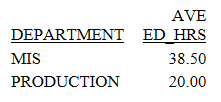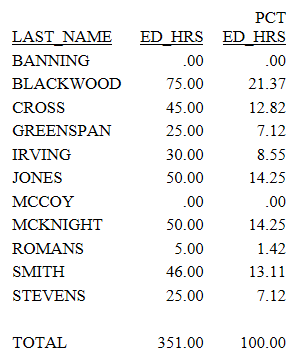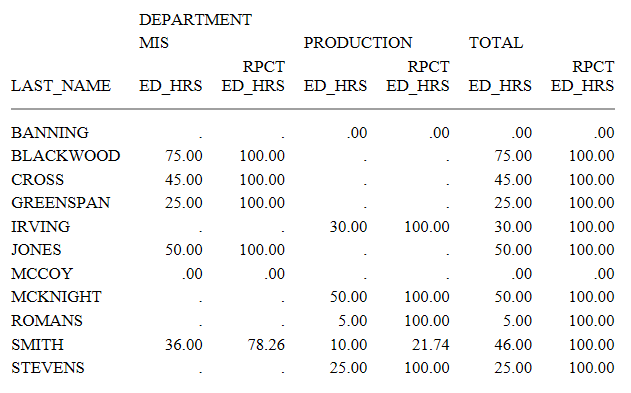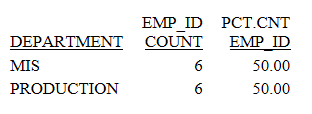Manipulating Display Fields With Prefix Operators
You can use prefix operators to perform calculations directly on the values of aggregated fields. Each prefix operator is applied to a single field, and affects only that field.
The syntax is:
{SUM|COUNT} prefix.fieldnameThe following table lists prefix operators and describes the function of each.
|
Prefix |
Function |
|---|---|
ASQ. |
Computes the average sum of squares for standard deviation in statistical analysis. |
AVE. |
Computes the average value of the field. |
AVE.DST. |
Averages the distinct values within a field. |
CNT. |
Counts the number of occurrences of the field, even if used with the SUM verb. The data type of the result is always Integer. |
CNT.DST. |
Counts the number of distinct values within a field. |
CT. |
Produces a cumulative total of the field. This operator only applies when used in subfoots. |
DST. |
Determines the total number of distinct values in a single pass of a data source. |
FST. |
Generates the first physical instance of the field. Can be used with numeric or text fields. |
LST. |
Generates the last physical instance of the field. Can be used with numeric or text fields. |
MAX. |
Generates the maximum value of the field. |
MDE. |
Computes the mode of the field values. |
MDN. |
Computes the median of the field values. |
MIN. |
Generates the minimum value of the field. |
PCT. |
Computes a field percentage based on the total value for the field. The PCT operator can be used with detail, as well as summary fields. |
PCT.CNT. |
Computes a field percentage based on the number of instances found. The format of the result is always F6.2. |
RNK. |
Ranks the instances of a BY sort field in the request. Can be used in PRINT commands, COMPUTE commands, and IF or WHERE TOTAL tests. |
ROLL. |
Recalculates values on summary lines using the aggregated values from lower level summary lines. |
RPCT. |
Computes a field percentage based on the total values for the field across a row. |
ST. |
Produces a subtotal value of the field at a sort break in the report. This operator only applies when used in subfoots. |
SUM. |
Sums the field values, even if used with the COUNT verb. |
SUM.DST. |
Sums the distinct values within a field. |
TOT. |
Totals the field values for use in a heading (includes footings, subheads, and subfoots). |
AVE. Prefix Operator
To calculate the average number of education hours spent in each department, issue the following request:
TABLE FILE EMPLOYEE SUM AVE.ED_HRS BY DEPARTMENT END
Run the request. The output is:

MAX. and MIN. Prefix Operators
To calculate the maximum and minimum values of SALARY, issue the following request:
TABLE FILE EMPLOYEE SUM MAX.SALARY AND MIN.SALARY END
Run the request. The output is:

PCT. Prefix Operator
To calculate the percentage that a field makes up of the column total value, for example, each employee share of education hours, issue the following request:
TABLE FILE EMPLOYEE SUM ED_HRS PCT.ED_HRS BY LAST_NAME ON TABLE COLUMN-TOTAL END
Run the request. The output is:

RCPT. Prefix Operator
To calculate the total education hours (ED_HRS column) and the percentage that total makes up in relation to the sum of all education hours (RPCT.ED_HRS) for each employee within department, issue the following request:
TABLE FILE EMPLOYEE SUM ED_HRS RPCT.ED_HRS ROW-TOTAL BY LAST_NAME ACROSS DEPARTMENT END
Run the request. The output is:

SUM and COUNT in the Same Request
To count the occurrences of EMP_ID and sum the value of ED_HRS, issue either of the following requests:
TABLE FILE EMPLOYEE SUM CNT.EMP_ID AND ED_HRS END
or
TABLE FILE EMPLOYEE COUNT EMP_ID AND SUM.ED_HRS END
Run the request. The output is:

PCT.CNT. Prefix Operator
To count the occurrences of EMP_ID and the relative percentage of the values in the EMP_ID field for each department, issue the following request:
TABLE FILE EMPLOYEE SUM CNT.EMP_ID PCT.CNT.EMP_ID BY DEPARTMENT END
Run the request. The output is:

CNT.DST. Prefix Operator
To count the number of unique ED_HRS values, issue either of the following requests:
TABLE FILE EMPLOYEE SUM CNT.DST.ED_HRS END
or
TABLE FILE EMPLOYEE COUNT DST.ED_HRS END
Run the request. The output is:

FST. and LST. Prefix Operators
To retrieve the first and last logical record in the EMP_ID field, issue the following request:
TABLE FILE EMPLOYEE SUM FST.EMP_ID LST.EMP_ID END
Run the request. The output is:

| WebFOCUS | |
|
Feedback |